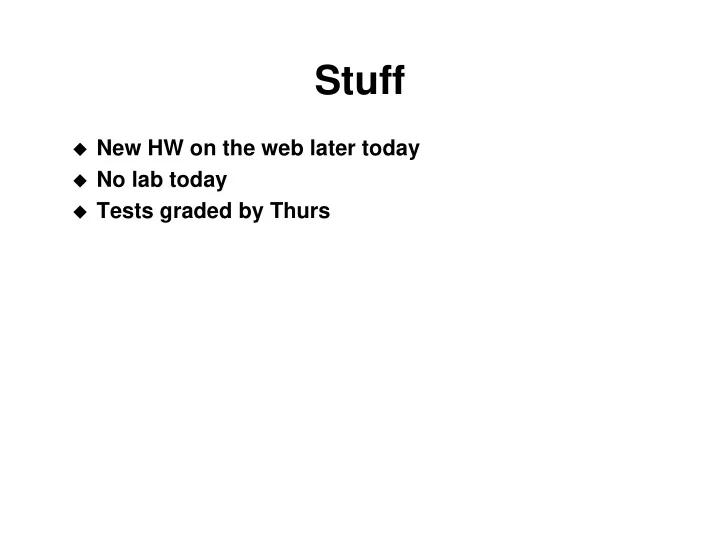

Stuff � New HW on the web later today � No lab today � Tests graded by Thurs
Last Time � CAN Bus � Intro � Low-level stuff � Frame types � Arbitration � Filtering � Higher-level protocols
Today � Embedded wireless networking – 802.15.4 � Characteristics � Layers � Spread spectrum intro � PHY layer � MAC layer � Superframes � Network layer
802.15.4 � Design choices relative to 802.11 (WiFi) and 802.15.1 (Bluetooth) � Simpler � Lower cost � Shorter range � Lower bandwidth � Lower power � Intended applications � Home networking • Motion detectors • Thermostats • Smoke detectors � Automotive networking � Industrial networking
802.15.4 � Defines only the PHY and MAC layers � Zigbee Alliance is an association of companies involved with building higher-layer standards based on IEEE 802.15.4 � Two device profiles � Full function – capable of being a network coordinator � Reduced function – end-node
Characteristics
Single-Chip 802.15.4 + MCU: ChipCon 2430 � 8051 processor � Old-style 8-bit, originated at Intel � 32 MHz, 8 KB RAM, 128 KB Flash � 802.15.4 radio on-chip � Short-range, low-power wireless � Zigbee is based on this � Low power: 25 mA for CPU + Zigbee receive � Low cost: <$4 in large quantities � This has potential to be big � Cheaply add wireless connectivity to any device • Examples?
Big Picture Upper Layers Other LLC IEEE 802.2 LLC IEEE 802.15.4 MAC IEEE 802.15.4 IEEE 802.15.4 868/915 MHz 2400 MHz PHY PHY � LLC == Logic Link Control
Two PHY Options � 2.4 GHz band has worldwide availability and provides a transmission rate of 250 kb/s � The 868/915 MHz PHY specifies operation in the 868 MHz band in Europe and 915 MHz ISM band in the United States � Offer data rates 20 kb/s and 40 kb/s respectively
Channel Structure
Brief Spread Spectrum Intro � Idea: � Sender spreads the signal over a larger bandwidth than it would ordinarily cover • Do this by adding high-frequency pseudo-random noise to the signal � Receiver “despreads” to recover original signal � Main goal: Increase resistance to interference � This is direct sequence spread spectrum � Other SS techniques exist � E.g. frequency hopping
Spread Spectrum
Spread Spectrum Example Period of one data bit Period of one chip
SS Keying � BPSK – Binary Phase-Shift Keying � 0 leaves chips unmodified � 1 flips sense of all chips � Encodes 1 bit per symbol � QPSK – Quadrature Phase-shift Keying � Beyond the scope of today’s lecture � Encodes 4 bits per symbol
Bandwidth Effects � Spreading: � Despreading:
Resistance to Interference
More Good Things � Resistance to interception: � This one doesn’t apply to 802.15.4! � Resistance to multipath effects: � Delayed paths are rejected (and can even be exploited)
802.15. 4 Modulation / Spreading � 868 MHz PHY � BPSK chip modulation at 300 kchips/s � Data rate 20 kbps � Spread factor of 15 � 915 MHz PHY � BPSK chip modulation at 600 kchips/s � Data rate 40 kbps � Spread factor of 15 � 2.4 GHz PHY � O-QPSK chip modulation at 2.0 Mchips/s � 62.5 k symbols/s, 4 bits/symbol � Data rate 250 kbps � Spread factor of 32
Physical Layer Packet Structure PHY Packet Fields • Preamble (32 bits) – synchronization • Start of Packet Delimiter (8 bits) • PHY Header (8 bits) – PSDU length • PSDU (0 to 1016 bits) – Data field Start of PHY PHY Service Preamble Packet Header Data Unit (PSDU) Delimiter 6 bytes 0-127 bytes
MAC Frame Structure
MAC Frame � Frame control field indicates the type of MAC frame being transmitted, specifies the format of the address field, and controls the acknowledgment � Multiple address types � 64 bit physical address � Short 16 bit network assigned addresses � Address field size may vary from 0 to 20 bytes � Payload field is variable size, at most 127 bytes � FCS is used for integrity check using 16 bit CRC
MAC Protocol � CSMA/CA – Carrier sense with multiple access and collision avoidance � Transmit when the medium is free • In not free, back off � Exceptions: • Beacons go out on a fixed time schedule • Acknowledgments are synchronous • Optional contention-free access
Superframes � Certain applications require dedicated bandwidth to achieve low latency for this � Optional superframe mode � PAN coordinator transmits superframe beacons in predetermined intervals � This interval divided into 16 time slots � PAN coordinator may assign time slots to devices requiring dedicated bandwidth or low-latency transmissions � These assigned time slots are called guaranteed time slots (GTS) and together form a contention-free period
Superframe Structure GTS 2 GTS 1 Contention Access Contention Free Period Period 15ms * 2 n where 0 ≥ n ≥ 14 Transmitted by network coordinator. Contains network information, Network beacon frame structure and notification of pending node messages. Beacon extension Space reserved for beacon growth due to pending node messages period Contention period Access by any node using CSMA-CA Guaranteed Reserved for nodes requiring guaranteed bandwidth Time Slot
Network Layer � Two or more 802.15.4 nodes form a PAN � ”Personal area network” � Two different types of devices � Full functional Device (FFD) • Coordinator and simple node • Any topology • Talks to any device � Reduced Functional Device (RFD) • Simple node only, either source or desination • Star topology only • Talks to network coordinator only
Star Topology
Mesh Topology
Combined Topology
Summary � Bluetooth – dying slowly? � 802.15.4 / Zigbee – cool stuff � Simple protocols � Very low power � Cheap � 801.15.4 might be big � Too early to tell � Probably depends on whether incremental cost / power requirements can be made very low
Recommend
More recommend